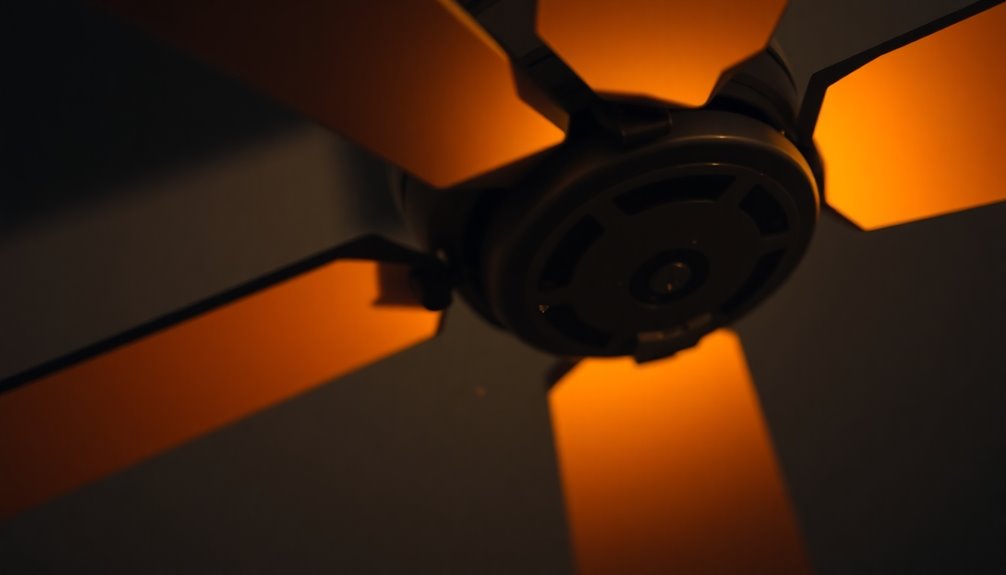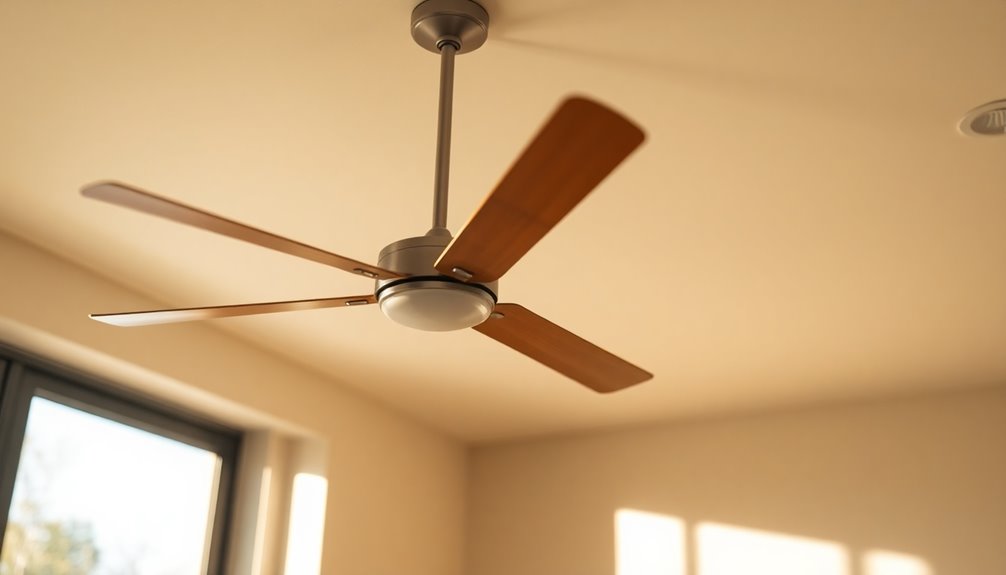If your ceiling fan is clicking, it might be due to loose blades, unbalanced components, or debris obstructing movement. First, check for any loose screws on the fan blades or the blade holders and tighten them if necessary. Inspect the blades for damage or imbalance, as wobbly blades can create noise. Additionally, foreign objects caught in the fan can also cause clicking sounds. If you notice any alarming signs like overheating or burning smells, it's best to turn off the fan and consult a professional. Discovering the specifics of your issue can help you achieve a quieter fan soon.
Key Takeaways
- Loose blades or blade holder screws can cause intermittent clicking noises in ceiling fans.
- Unbalanced blades lead to consistent clicking due to wobbling during operation.
- Foreign objects or debris may obstruct blade movement, resulting in clicking sounds.
- Improper installation or misalignment of blade holders can contribute to persistent clicking noises.
- Electrical issues, such as overheating or wiring faults, could also be responsible for clicking sounds.
Common Causes of Clicking Noises

When your ceiling fan starts making clicking noises, it's usually due to a few common culprits. One major reason could be loose blades or blade holder screws. When these screws aren't tightened properly, you might hear intermittent clicking as the blades move.
Additionally, unbalanced blades can cause consistent clicking sounds. If the blades wobble or aren't aligned correctly, they may come into contact with other components of the fan assembly, leading to annoying noises.
Another factor to take into account is foreign objects or debris that might obstruct the blades' movement. Regular maintenance is essential in this case; a quick inspection and cleaning can prevent such issues from arising.
Improper installation of blade holders or misalignment can also contribute to clicking noises. If the fan assembly isn't put together correctly, you'll likely encounter these disturbances.
To keep your fan running smoothly and quietly, it's important to perform regular maintenance, including tightening screws and checking for any defects or misalignments.
Diagnosing the Clicking Issue

Diagnosing the clicking issue with your ceiling fan involves a systematic approach to identify the source of the noise.
First, start by checking for any obvious problems that could lead to clicking noises. You can follow these simple steps to help diagnose and fix the issue:
- Inspect the fan blades for any foreign objects obstructing their movement.
- Check for loose blades or blade holder screws; tighten the screws if necessary.
- Look for any wobbling or bent blade arms that might be causing an imbalance.
- Verify all screws on the blades and blade holders are tightened properly.
If the clicking persists, consider contacting a professional for further evaluation.
Inspecting Fan Blades and Screws

You should start by checking the tightness of the fan blades, as loose screws can lead to unwanted clicking sounds.
Next, inspect the blades for any visible damage like cracks or warping, which can throw the fan off balance.
Addressing these issues promptly can help maintain your fan's performance and silence those annoying noises.
Check Blade Tightness
One key factor in eliminating clicking noises from your ceiling fan is checking the tightness of the blade screws. Loose screws can cause vibrations and imbalances that create those annoying ceiling fan noises.
To guarantee a smooth operation, follow these steps:
- Use a ladder to access your ceiling fan blades safely.
- Inspect the screws on the end of each blade for any signs of looseness.
- Tighten any loose screws securely, but don't overtighten, as this can bend or damage the blade.
- Regularly maintain your fan by checking blade tightness to prolong its lifespan.
If clicking persists after tightening, consider checking for other issues, like warped blades or loose blade arms.
Inspect for Damage
After ensuring the blade screws are tight, it's important to inspect the fan blades and screws for any signs of damage. Damaged fan blades can result in imbalance, leading to those frustrating clicking noises you hear when the fan operates. Always check for cracks or warping, as these issues will only worsen over time.
Additionally, keep an eye out for loose screws; they're a common culprit behind clicking sounds. Addressing this promptly can prevent further damage. Don't forget to look for any foreign objects obstructing blade movement, as these can also contribute to unwanted noise.
To help you remember what to check, here's a quick reference table:
| Inspection Item | What to Look For | Recommended Action |
|---|---|---|
| Fan Blades | Cracks or warping | Replace if necessary |
| Blade Screws | Tightness | Tighten if loose |
| Blade Arms | Deformation or misalignment | Adjust or replace as needed |
| Foreign Objects | Any obstruction | Remove immediately |
Performing periodic maintenance, like inspecting for damage, can greatly reduce the likelihood of noise issues developing over time.
Checking for Loose Canopy

When troubleshooting clicking noises from your ceiling fan, checking for a loose canopy is an important step. A loose canopy can rub against the ceiling or downrod, creating those annoying sounds.
It's vital to periodically inspect the canopy to verify it's secure, as this can prevent noise and promote smooth operation.
Here's how to check for a loose canopy:
- Gently wiggle the canopy to detect any movement.
- Listen for rattling sounds that indicate instability.
- Inspect all visible fasteners around the canopy.
- Use a screwdriver to tighten any loose screws.
- Schedule regular maintenance to catch issues early.
Assessing Electrical Components

While securing the canopy is important for reducing noise, clicking sounds could also stem from issues within the electrical components of your ceiling fan.
If your fan is controlled by a variable speed switch or a remote control system, compatibility with the fan's motor might be causing those annoying clicking noises.
Loose or damaged wiring connections can lead to intermittent electrical signals, making the fan struggle to maintain consistent power. This inconsistency can manifest as clicking sounds during operation.
Additionally, electrical interference from other household appliances on the same circuit may contribute to the noise, so it's worth checking the circuit you're using.
Inspect the fan's wiring for any signs of fraying or damage. If you notice anything that looks loose or damaged, it could signal a potential electrical hazard that's contributing to the clicking noise.
If you suspect electrical issues, don't hesitate to consult with a qualified electrician. They can safely diagnose and address any wiring or compatibility problems affecting your fan's performance, ensuring both safety and quiet operation.
Maintenance Tips to Prevent Noise

Proper maintenance is key to preventing clicking noises from your ceiling fan. By following some simple maintenance tips, you can keep your fan running smoothly and quietly.
Here are five essential steps you should take:
- Clean your ceiling fan regularly: Dust accumulation can cause imbalance, leading to annoying clicking sounds.
- Inspect blades for damage: Look for wobbly or warped blades and replace them to maintain proper balance.
- Tighten loose screws: Periodically check all screws and fasteners on the blades and light fixtures, ensuring everything is secure.
- Check the fan canopy: Inspect for any looseness and tighten visible fasteners to eliminate rattling noises.
- Perform fan motor lubrication: Follow the manufacturer's recommendations to lubricate the fan motor and bearings, minimizing friction and reducing noise.
When to Seek Professional Help

If your ceiling fan keeps clicking after you've tightened the screws and checked for loose parts, it's time to call in a professional.
Persistent noise could signal an underlying mechanical or electrical problem that needs expert evaluation.
Don't ignore any crackling sounds, as these may indicate serious electrical hazards that require immediate attention.
Persistent Noise Issues
Dealing with persistent clicking noises from your ceiling fan can be frustrating, especially when basic troubleshooting hasn't resolved the issue.
If you've tightened all screws and checked for loose components, but the noise persists, it's time to reflect that there may be deeper mechanical issues at play.
Here are some signs that indicate you should seek professional help:
- Continuous clicking sounds that remain after DIY fixes
- Unusual grinding or humming accompanying the clicking
- A noticeable increase in the noise over time
- The clicking noise has lasted for several weeks without improvement
- An imbalance in the fan blades that you can't correct
When you notice these symptoms, it's essential to consult a qualified electrician.
They can perform a professional evaluation to guarantee safe handling of any electrical components and identify underlying issues that mightn't be apparent during a DIY inspection.
Ignoring these persistent clicking noises could lead to further damage, so don't hesitate to reach out for expert assistance.
Taking action now can save you from more costly repairs down the line.
Electrical Concerns Present
Electrical safety is paramount when dealing with a ceiling fan that emits clicking noises. If your noisy ceiling fan starts producing clicking sounds along with crackling or sizzling, it's a sign of potential electrical issues that could pose a fire hazard. Don't ignore these warning signs; immediate attention is vital.
If you've tightened all visible screws but the clicking persists, you likely have underlying wiring problems. In this case, you should schedule a professional inspection to guarantee safety and functionality.
Should you notice clicking noises linked to dimmable LED lights or incompatible control systems, consulting a licensed electrician is essential for accurate diagnosis and resolution.
Furthermore, if you detect signs of overheating or a burning smell alongside the clicking noises, shut off the power immediately. This situation demands a professional evaluation to prevent further risks.
If your troubleshooting efforts don't resolve the clicking sound and you suspect electrical malfunctions, it's wise to seek help from a licensed electrician. They've the expertise to identify and rectify the issue, ensuring your ceiling fan operates safely and efficiently.
Your safety should always come first.
Choosing a Quiet Ceiling Fan

When selecting a ceiling fan, noise levels can considerably impact your comfort. To guarantee you get a quiet ceiling fan, consider the following factors:
- Blade Material: Opt for timber or plastic blades, as they're generally quieter than metal blades.
- Number of Blades: More blades can lead to a quieter experience. They allow for lower fan speeds, reducing noise while maintaining airflow.
- Blade Design: Choose fans with rounded blades instead of square-cut ones. Rounded designs minimize air disturbance and create less noise.
- Downrod Length: Shortening the downrod can enhance stability, preventing imbalance or excessive movement that may cause noise, especially in lower ceilings.
- DC-Powered Ceiling Fans: Consider these models, as they're designed to operate quietly and can save you up to 70% in energy costs compared to traditional AC fans.
Frequently Asked Questions
How Do I Stop My Ceiling Fan From Clicking?
To stop your ceiling fan from clicking, start by checking the fan blades.
Make certain all screws are tight, as loose blades often cause noise. Look for any debris obstructing the blades, and remove it.
If the clicking continues, inspect the blade arms for bends or warping.
Finally, examine the motor for wear and guarantee regular cleaning and lubrication to maintain smooth operation and prevent future clicking sounds.
Why Is There a Weird Clicking Sound in My Ceiling?
If you hear a weird clicking sound in your ceiling, it could be due to several factors.
Check for loose fixtures, as they can create vibrations.
Inspect for any foreign objects lodged in the area.
Sometimes, it's just a matter of shifting materials as your house settles.
If the sound persists, you might want to call a professional to guarantee everything's secure and functioning properly to avoid potential issues.
Why Is My Ceiling Fan Making a Knocking Noise?
Imagine your ceiling fan whirling gracefully, then suddenly, a persistent knocking interrupts the serene flow.
This noise often signals loose blades or screws that need tightening. It might also be that the blades are misaligned, or something's caught in the assembly, disrupting their dance.
Regularly check for tightness and alignment to keep your fan in harmony. If the knocking doesn't fade, it might be time to call in a professional for a closer look.
Is It Okay if My Ceiling Fan Is Making Noise?
It's not uncommon for ceiling fans to make some noise, but if the sound is persistent, you should take action.
A clicking noise might indicate loose parts or unbalanced components, which can lead to bigger issues down the line.
Regular maintenance is essential; check for loose screws and guarantee everything's secure.
Conclusion
In wrapping things up, if your ceiling fan's clicking is driving you up the wall, it's crucial to pinpoint the cause. By inspecting blades, screws, and electrical components, you can often solve the issue yourself. Regular maintenance can help keep the noise at bay. However, if the problem persists, don't hesitate to call in a pro. Remember, it's better to be safe than sorry when it comes to your home's comfort and safety.









